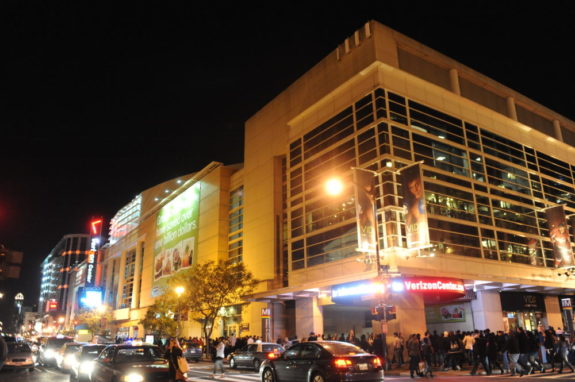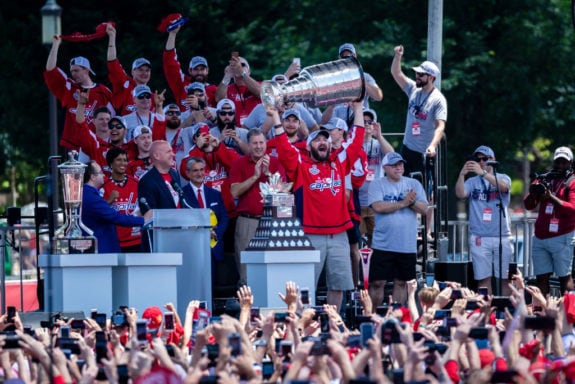Twenty-three years ago this Saturday, the Washington Capitals played their first-ever NHL game in the District, defeating the Florida Panthers 3-2 in overtime at then-MCI Center on Dec. 5, 1997.
The Capitals franchise is rapidly approaching the date of where they will have spent more time of their existence in their Chinatown home, now called Capital One Arena, and the time they spent in their first home, the Capital Centre in Landover.

If you count Washington’s first-ever game in Maryland, the team spent 8,461 days at the Capital Centre. Washington took the ice for the first time at home on Sept. 27, 1974, with a 4-4 tie against the Montreal Canadiens in a preseason game, spanning over two decades in Landover before their final game in the building against the same Canadiens on Nov. 26, 1997.
On Feb. 3, 2021, Washington will equal that stretch of days since it first played a game in Chinatown, dating back to that 1997 contest. The team will soon officially have spent more time in the city than the suburbs, a change that had a profound impact on the team and city itself in the years since.
So, how has the two different eras of Capitals history impacted the team?
Capital Centre’s Modern Look Fades
The first years of the Capitals franchise were spent in the then state-of-the-art Capital Centre. The saddle-shaped building featured the NHL’s first projection video screen hung above center ice, known as the “Telscreen” – which left many players on visiting benches looking up at game replays – and also was the first arena to feature luxury boxes.
Built just off the Beltway in Landover, Maryland, for $18 million the Capital Centre was designed for the suburbs, with no public transportation – it predated Metro by two years – leading to traffic jams off both Central Avenue and Landover Road getting in and out of games. While Capitals owner Abe Pollin had wanted to build an arena in downtown Washington, it proved easier and less expensive to build on land in Prince George’s County that was easily accessible by car, but exceedingly difficult without one.
It also meant the bulk of the Capitals’ ticket base was from Maryland, from Prince George’s County, Montgomery County, as well as along the I-95 corridor where it was easier to get to the arena. While the team had a presence in Virginia and the District, the distance and crossing the Beltway’s two bridges made the trip a little further for some fans commuting from those locales.
Hockey-wise, the arena was a dark place, with the blue and red seats paling against the Telscreen and lights on the rink itself. Certainly, the early Washington teams weren’t overly successful, but the Rod Langway trade in 1982 energized the franchise and the team would draw sellout crowds in the latter half of the season once the Redskins season was done.
The arena hosted the 1982 NHL All-Star Game, and two memorable Game 7s in the Easter Epic against the New York Islanders in 1987 and the Dale Hunter overtime win over the Philadelphia Flyers a year later. But despite some competitive teams with several future Hall of Famers, the arena just saw one conference final in 1990 when the Boston Bruins swept the Caps out.
But the once-modern Capital Centre began to age, and other buildings started being built that were more modern as video screens became the standard, and luxury boxes were put in the second deck rather than high atop the cheap seats as in Landover.
Shift to District Means Shift in Fan Base
Pollin decided in the mid-1990s to build on a site in Chinatown as the new home for his two teams. The NHL and NBA both were in a boom of building new homes for their arenas, and unlike the Capital Centre, the $260 million arena went on top of the Gallery Place Metro station, meaning public transportation would be the preferred method of getting to and from games instead of driving.
While the Gallery Place neighborhood wasn’t overly developed when the teams moved in, with plenty of empty lots and vacant buildings surrounding the gleaming new arena, that quickly changed, as new bars, restaurants and shops sprung up shortly after the building’s completion.
The arena’s location was geared more towards corporate clients who were working in the city, and as a result, the team’s ticket base began to shift westward into Virginia and the District, with the Maryland segment shrinking accordingly.
There was a period of growing pains for the franchise with the move, however, as some longtime fans who had become accustomed to driving to Landover opted not to hop on the subway to head downtown, and the city’s corporate culture opted more for the NBA rather than the NHL. But that would change as the team remained competitive and eventually some big names were added to the Capitals roster as the neighborhood around it grew.
The new arena quickly got some national exposure, as the much-brighter venue with purple seats got to host the 1998 Stanley Cup Final, something the Capitals never managed to accomplish when playing in Maryland. A year later, the team was sold to current owner Ted Leonsis, who brought in an effort to market and reenergize the flagging fan base.
Two years after Leonsis bought the team, the club traded for Jaromir Jagr to try and sell tickets, and then oversaw a rebuilding effort that landed Alexander Ovechkin in the 2004 NHL Draft lottery.
Capitals, Fan Base Grows in the City
As the area around the arena started to grow, so did the scene surrounding Capitals games. Instead of hopping into a car and driving to a parking lot and driving back home as had been the case in Landover, fans now could come in early to grab food or drinks before and after games, and the neighborhood became one of the most popular in the city, just years after being mostly vacant.
Before the pandemic, the Capitals have had sellout crowds for each contest since January of 2009, a span of 490 games per the team, and in 2018, the Capitals brought the Cup back to the arena. Fans packed the once-vacant streets surrounding the arena watching the games on the video screen, and certainly the team had been more a part of the city than it had been in Maryland.
While the team clinched the title on the road, it made the banner-raising that October a memorable one as Ovechkin was able to skate in front of the home fans for the first time.

The shift from the suburbs to the city certainly change the Capitals franchise, as a team that once was on the fringes of the Washington sports scene literally and figuratively has now brought itself to the mix of the city’s sports base.
So, while Washington will soon quietly pass a major milestone of being a city resident longer than a suburban one, the transformation from the two arenas also helped the team reach a prominent spot in both the NHL and the city itself.